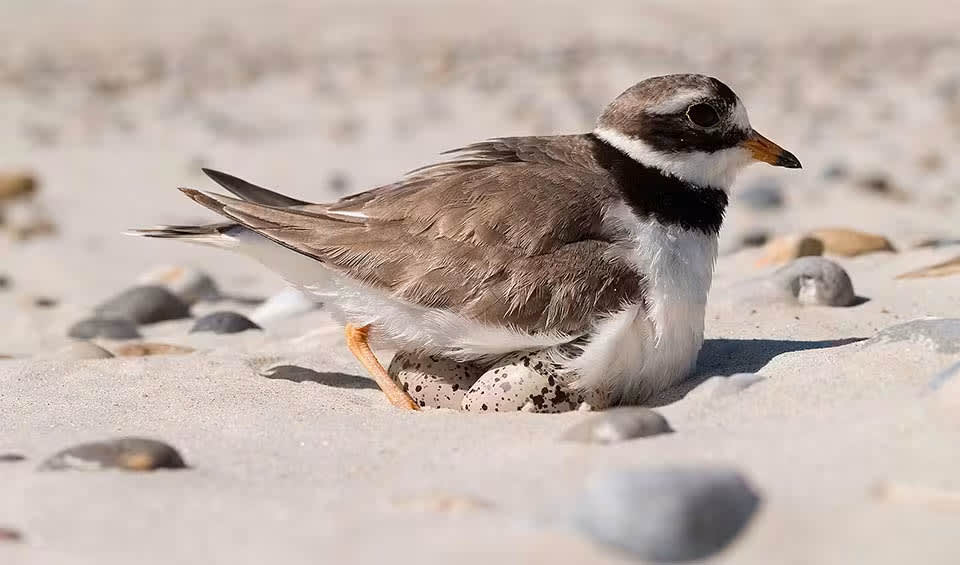With its striking black and white plumage adorned by vibrant orange-yellow features, it is a distinctive shorebird found across a diverse range of habitats. Characterized by its black lobes, ear coverts, forehead base, and frontal bar, this plover sports a contrasting bright white brow and a conspicuous white supercilium that extends above and behind its dark brown eyes.
The bill of the Common Ringed Plover is a striking orange-yellow, tipped with black during the breeding season, adding to its eye-catching appearance. Outside of the breeding season, the bill may appear duller in color. Encircling its dark eyes is a thin, yet distinct, eyering of dull yellowish-orange. Remarkably, the legs and feet of this avian marvel are a brilliant shade of orange-yellow, contributing to its overall vibrant aesthetic. Notably, the feet lack a basal web between the middle and outer toes, a characteristic feature of the species.
Breeding primarily on shingle or sandy coastal beaches, sandbars, mudflats, and estuaries, the Common Ringed Plover demonstrates remarkable adaptability by also nesting inland along rivers and lakes. In these inland habitats, it can be found in open tundra with sparse vegetation, as well as adjacent meadows and farmland. During the breeding season, rocky beaches, estuary mudflats, saltpans, and marshes serve as favored foraging grounds for this agile shorebird.
Outside of the breeding season, the Common Ringed Plover exhibits a preference for a variety of coastal habitats, including rocky shores, estuary mudflats, saltpans, and marshes. These diverse habitats provide ample opportunities for foraging and roosting as the plover navigates its annual migratory cycle.
Distribution
 Afghanistan
Afghanistan Albania
Albania Algeria
Algeria Angola
Angola Armenia
Armenia Australia
Australia Austria
Austria Azerbaijan
Azerbaijan Bahrain
Bahrain Bangladesh
Bangladesh Barbados
Barbados Belarus
Belarus Belgium
Belgium Benin
Benin Bosnia And Herz.
Bosnia And Herz. Botswana
Botswana British Indian T.
British Indian T. Brunei
Brunei Bulgaria
Bulgaria Burkina Faso
Burkina Faso Burundi
Burundi Cameroon
Cameroon Canada
Canada Cape Verde
Cape Verde Central Af. Rep.
Central Af. Rep. Chad
Chad China
China Comoros
Comoros Congo-Brazzaville
Congo-Brazzaville Croatia
Croatia Cyprus
Cyprus Czechia
Czechia Côte D’ivoire
Côte D’ivoire DR Congo (Kinshasa)
DR Congo (Kinshasa) Denmark
Denmark Djibouti
Djibouti Egypt
Egypt Equatorial Guinea
Equatorial Guinea Eritrea
Eritrea Estonia
Estonia Eswatini
Eswatini Ethiopia
Ethiopia Faroe Islands
Faroe Islands Finland
Finland France
France Gabon
Gabon Gambia
Gambia Germany
Germany Ghana
Ghana Gibraltar
Gibraltar Greece
Greece Greenland
Greenland Guam
Guam Guinea-Bissau
Guinea-Bissau Guinea
Guinea Hong Kong
Hong Kong Hungary
Hungary Iceland
Iceland India
India Iran
Iran Iraq
Iraq Ireland
Ireland Israel
Israel Italy
Italy Japan
Japan Jordan
Jordan Kazakhstan
Kazakhstan Kenya
Kenya Kuwait
Kuwait Kyrgyzstan
Kyrgyzstan Latvia
Latvia Lebanon
Lebanon Lesotho
Lesotho Liberia
Liberia Libya
Libya Liechtenstein
Liechtenstein Lithuania
Lithuania Luxembourg
Luxembourg Madagascar
Madagascar Malawi
Malawi Malaysia
Malaysia Maldives
Maldives Mali
Mali Malta
Malta Mauritania
Mauritania Mauritius
Mauritius Mayotte
Mayotte Micronesia
Micronesia Mongolia
Mongolia Montenegro
Montenegro Morocco
Morocco Mozambique
Mozambique Myanmar
Myanmar Namibia
Namibia Netherlands
Netherlands New Zealand
New Zealand Niger
Niger Nigeria
Nigeria Nort. Mariana Is.
Nort. Mariana Is. North Korea
North Korea North Macedonia
North Macedonia Norway
Norway Oman
Oman Pakistan
Pakistan Palau
Palau Philippines
Philippines Poland
Poland Portugal
Portugal Qatar
Qatar Romania
Romania Russia
Russia Rwanda
Rwanda Réunion
Réunion Saint Helena
Saint Helena Saudi Arabia
Saudi Arabia Senegal
Senegal Serbia
Serbia Seychelles
Seychelles Sierra Leone
Sierra Leone Singapore
Singapore Slovakia
Slovakia Slovenia
Slovenia Somalia
Somalia South Africa
South Africa South Sudan
South Sudan Spain
Spain Sri Lanka
Sri Lanka Sudan
Sudan Svalbard
Svalbard Sweden
Sweden Switzerland
Switzerland Syria
Syria Taiwan
Taiwan Tanzania
Tanzania Thailand
Thailand Togo
Togo Trinidad & Tobago
Trinidad & Tobago Tunisia
Tunisia Turkey
Turkey Turkmenistan
Turkmenistan UAE
UAE Uganda
Uganda Ukraine
Ukraine United Kingdom
United Kingdom United States
United States Yemen
Yemen Zambia
Zambia Zimbabwe
ZimbabweAnything we've missed?
Help us improve this page by suggesting edits. Glory never dies!
Suggest an editGet to know me
Terrestrial / Aquatic
Altricial / Precocial
Polygamous / Monogamous
Dimorphic (size) / Monomorphic
Active: Diurnal / Nocturnal
Social behavior: Solitary / Pack / Herd
Diet: Carnivore / Herbivore / Omnivore / Piscivorous / Insectivore
Migratory: Yes / No
Domesticated: Yes / No
Dangerous: Yes / No




